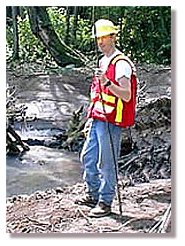Monitoring the Flows
By Damien Barstead
Most of the Creekside News issues have been focussed on the current efforts to
restore Haig-Brown Kingfisher Creek, specifically, the new stream channel under construction.
Little, however, has been said about the current water quality of the existing flows of the
creek.
Jeff Mason, the Creek’s Site Naturalist, has had the task of performing
water quality tests over the past few years. During this time, he has diligently gone out twice
weekly and taken an array of measurements.

Jeff Mason is in charge of water
quality
monitoring in the Haig-Brown
Kingfisher Creek System
Jeff has been doing tests in two different locations, which are quite a distance from each
other, in order to isolate where any differences in water quality might be occurring. In addition,
he is currently digging new test pits in the stream to test the water in the new creek channel. This
is to ensure that there will be top water quality in the stream when the project is completed.
The following are parameters that are regularly taken to indicate the
general health of the water:
- Flow conditions:
- Measurements here include water discharge and velocity. These
indicate how much water is in the channel and how fast it is moving.
- Temperature:
- This is a simple measurement that indicates how well the waters are protected from the
sun’s powerful rays.
|
pH:
This is a measurement of the acidity or alkalinity of the water.
Generally, water with a pH of 7 (neutral) is desired.
Dissolved oxygen:
Dissolved oxygen is very important because fish need oxygen to
breathe. This oxygen gets mixed into the water from the air when the flows get churned over
rocks and other disruptions or, when oxygen is released from vegetation.
Nitrates/Nitrites:
Nitrates/nitrites are nitrogen contaminants that can originate from
a variety of sources such as fertilizers and other commercial waste. These pollutants are
potentially quite toxic to fish.
Ammonia:
Ammonia is highly acidic and harmful to fish. It can enter the
stream from several sources; one common source is urine from farm animals.
Chlorinity:
The amount of chlorine in the water can severely affect the health
of the fish.
When taking these measurements, consistency is essential. Any
discrepancy might indicate some pollution or contamination source upstream that should be
investigated. On a larger scale, observing data compiled from past test observations can
demonstrate changing trends in the system. For example, if water levels drop consistently, even
by the smallest amount, it indicates that the creek may be losing some valuable water and may
eventually not have high enough flows for its swimming residents.
For more information on the importance of water quality and the
significance of the above parameters, just click on the water in the habitat section in the main
Pacific Coast Salmon Fisheries site (available this September).
Top of page.
|

